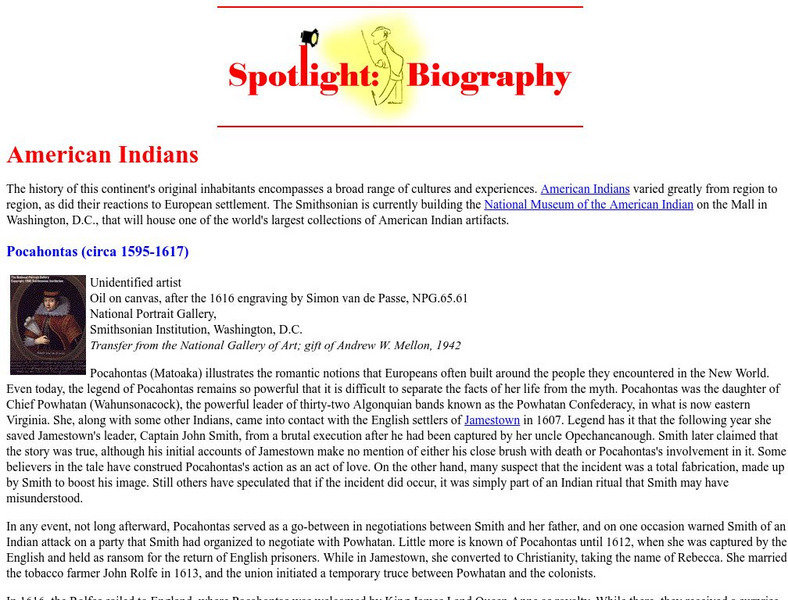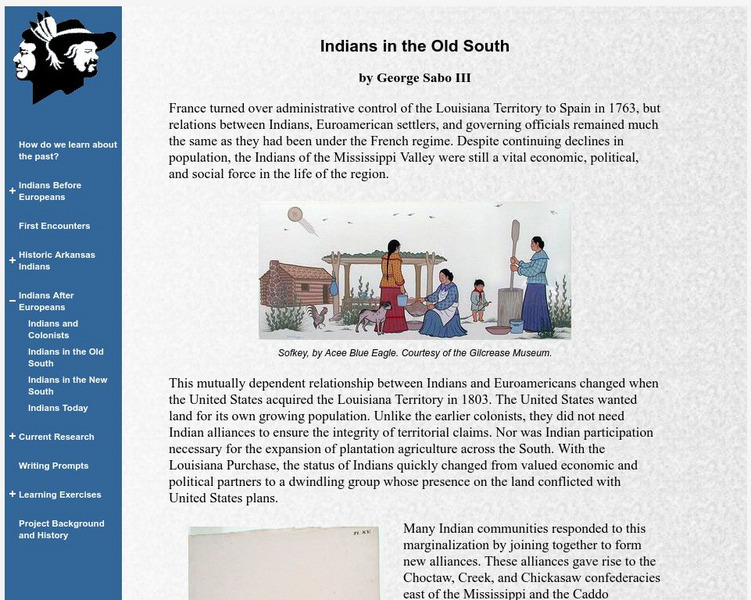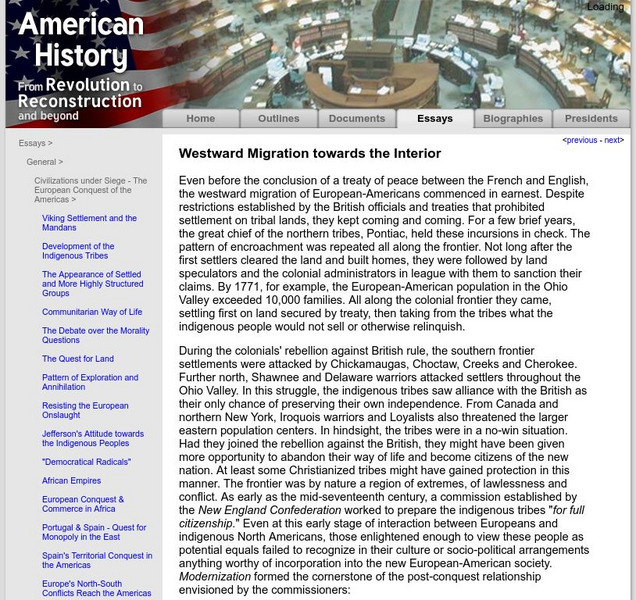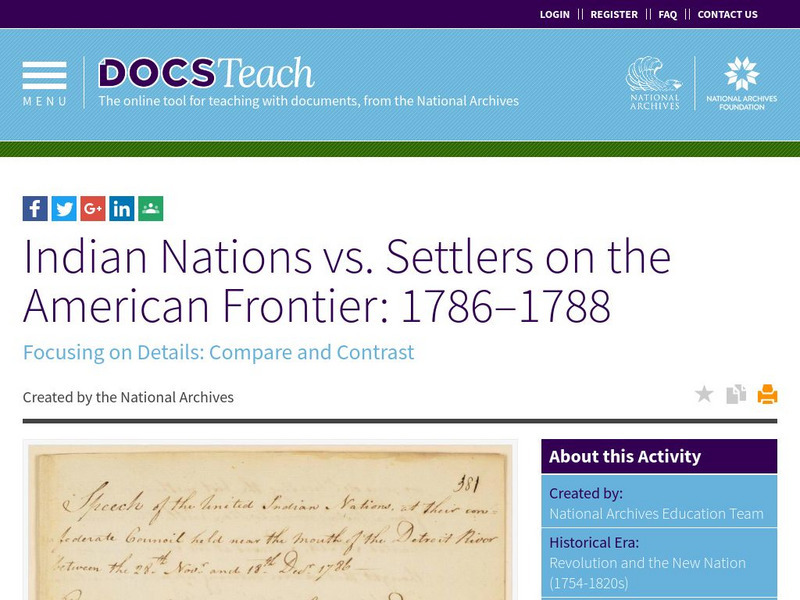Hi, what do you want to do?
The Newberry Library
Newberry Library: Art of Conflict: Portraying American Indians, 1850 to 1900
Lesson uses digitized primary source material to examine the portrayal of American Indians in art between 1850 and 1900. Classroom activities and questions for discussion included.
Smithsonian Institution
National Museum of the American Indian: A Song for the Horse Nation
This exhibit from the National Museum of the American Indian explores the close relationship of Native Americans and their horses through art, pottery, textiles, artifacts, and photographs. It traces this relationship from the 15th...
Other
Uintah Basin Tah Project: American Indians 101: Frequently Asked Questions
Provides answers to commonly asked questions about Native Americans, e.g., how they are defined, the proper terms to use, and what a reservation is, as well as questions about their relationship with the federal and state governments,...
A&E Television
History.com: Native Americans Weren't Guaranteed the Right to Vote in Every State Until 1962
Native people won citizenship in 1924, but the struggle for voting rights stretched on much longer. Native Americans couldn't be U.S. citizens when the country ratified its Constitution in 1788, and wouldn't win the right to be for 136...
PBS
Pbs: The Native Americans
The Corps of Discovery came into contact with "Nearly 50 Native American tribes." This site from PBS discusses the tribes that had the most significant interactions with Lewis and Clark.
Smithsonian Institution
National Museum of the American Indian: Song for the Horse Nation
An exhibition about horses in Native American cultures takes a sweeping look at the ways in which Native peoples, past and present, regard horses and horsemanship. Learn how the horse transformed Native approaches to the hunt, warfare,...
Other
Defense: American Indian Heritage Month: Code Talkers
Find out about the Native Americans who used their tribal languages as code during World War I and World War II. Includes information on Charles Chibitty, a Comanche code talker who was inducted into the Pentagon's Hall of Heroes.
Rutherford B. Hayes Presidential Library & Museum
United States Indian Policy During the Late 19th Century: Change and Continuity
By the 1890's, the status of Indian people seemed to validate Frederick Jackson Turner's claim that "the frontier has gone, and with its going has closed the first period of American history." Natives ceased to threaten the Republic...
OpenStax
Open Stax: The Loss of American Indian Life and Culture
Read this section from a chapter on "Westward Expansion" to learn about the methods that the U.S. government used to address the "Indian threat" during the settlement of the West and explain the process of "Americanization" as it applied...
Curated OER
History Matters: John Collier Promises to Reform Indian Policy
Find the report by John Collier, Commissioner of Indian Affairs, to the Secretary of the Interior, describing how he was trying to right many of the wrongs in the federal government's dealings with Native Americans as a result of the...
US National Archives
Docsteach: Assimilation of American Indians
In this activity, students will analyze primary sources to determine the role and activities the federal government undertook in an attempt to 'Americanize' or assimilate Native Americans.
CommonLit
Common Lit: Excerpts From Thomas Jefferson's Writings on American Indians
A learning module that begins with the historical text "Excerpts from Thomas Jefferson's Writings on American Indians" accompanied by guided reading questions, assessment questions, and discussion questions. The text can be printed as a...
Other
Native Languages of the Americas: Native American Headdresses: Facts for Kids
Describes the different types of headdresses worn by Native American groups across North, Central and South America. (Note: some links to larger images no longer work.)
Curated OER
National Park Service: Five Views: A History of American Indians in California
A history of five tribes in the California Native American culture area.
Smithsonian Institution
Smithsonian Education: Spotlight Biography: American Indians: Black Hawk
Scroll down to the portrait of Black Hawk to read a brief biography of this famous Native American chief. From the Smithsonian Institution.
Other
Arkansas Archeological Survey: Indians of Arkansas Indians in the Old South
After the Louisiana Purchase, the status of the Native Americans changed from partners to a declining group whose presence conflicted with United States plans. Follow the events which changed and reshaped the lives of these Native peoples.
Other
Victoriana Magazine: Native American Tribes and u.s Government
The U.S. government's policies towards Native Americans in the second half of the nineteenth century were influenced by the desire to expand westward into territories occupied by these Native American tribes. By the 1850s nearly all...
University of Groningen
American History: Essays: Western Migration Towards the Interior
This resource provides an essay discussing the migration of American colonists into the Ohio River Valley and the impact on the Native Americans living in the area.
Ohio State University
Osu History Teaching Institute: Native American History: John Smith and the Powhatan
This lesson relates to understanding primary sources to evaluate John Smith's description of the Powhatan Indians.
Other
Monticello: President Jefferson & the Indian Nations
This resource discusses how Thomas Jefferson sought to bind Native Americans to the United States through treaties for security reasons and how he tried to get the Indians to adapt to a way of life like the white settlers' way of life.
Virginia Historical Society
Virginia Museum of History and Culture: Early Images of Virginia Indians
A collection of images of early Virginia Indians that includes information on interpreting the images and shows fanciful images that were not historically accurate.
A&E Television
History.com: The Native American Chief Who Drove Out Spanish Colonists and Nearly Expelled the English
In the summer of 1561, Spanish explorers abducted Opechancanough, a Powhatan Indian youth from the Chesapeake Bay tidewater region and brought him to the royal court of Spain. The kidnapping set off a chain of events that would alter the...
US National Archives
National Archives: Indian Nations vs. Settlers on the American Frontier
When the Revolutionary War ended, there was an ongoing conflict between the Native Americans and American settler in the Northwest Territory. Learners will study two documents from each side of the issue and answer questions and/or hold...
Other popular searches
- Art Native American Indians
- Native American Indians Nj
- Native American Indians 4th
- American Native Indians





















